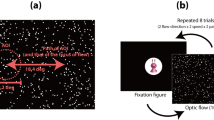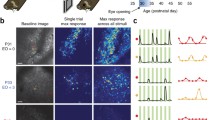Abstract
We examined the sensitivity of 2- and 3-month-old infants to radial expansion/contraction at various speeds. The stimuli comprised one radial motion pattern (expansion or contraction) and one translational motion pattern (up, down, left or right; counterbalanced across infants) placed side by side. The two patterns in each stimulus had the same speed. Three-month-old infants could discriminate between radiation and translation, even under relatively low speeds (5.31 and 2.66°/s), whereas discrimination between the two patterns by 2-month-old infants was very limited. Thus, the range of speeds at which infants can detect radial expansion/contraction changes extensively between 2 and 3 months of age. This change in radial motion sensitivity may reflect the development of cortical motion mechanisms in the dorsal pathway, which is specialised to detect radial motion.


Similar content being viewed by others
References
Aslin RN, Shea SI (1990) Velocity thresholds in human infants—implications for the perception of motion. Dev Psychol 26:589–598
Atkinson J (1979) Development of optokinetic nystagmus in the human infant and monkey infant: an analogue to development in kittens. In: Freeman RD (ed) Developmental neurobiology of vision. NATO advanced study institute series. Plenum Press, New York
Atkinson J, Braddick OJ (1981) Development of optokinetic nystagmus in infants: an indicator of cortical binocularity? In: Fisher DF, Monty RA, Senders JW (eds) Eye movements: cognition and visual perception. Lawrence Erlbaum Associates, Hillsdale, NJ, pp 53–64
Ball WA, Ballot R, Dibble A (1983) Stimulus dimensionality and infants’ perceived movement in depth. J Genet Psychol 143:193–200
Ball K, Sekuler R (1980) Human vision favors centrifugal motion. Perception 9:317–325
Ball W, Tronick E (1971) Infant responses to impending collision: optical and real. Science 171:818–820
Banton T, Bertethal BI (1996) Infants’ sensitivity to uniform motion. Vision Res 36:1633–1640
Banton T, Bertenthal BI (1997) Multiple developmental pathways for motion processing. Optom Vision Sci 74:751–760
Banton T, Bertenthal BI, Seaks J (1996) Infants’ sensitivity to statistical distributions of motion direction and speed. Vision Res 39:3417–3430
Banton T, Dobkins K, Bertenthal BI (2001) Infant direction discrimination thresholds. Vision Res 41:1049–1056
Bertenthal BI, Bradbury A (1992) Infants’ detection of shearing motion in random-dot display. Dev Psychol 28:1056–1066
Bex PJ, Makous W (1997) Radial motion looks faster. Vision Res 37:3399–3405
Bower TGR, Broughton JM, Moore MK (1970) Infant response to approaching objects: an indicator of response to distal variables. Percept Psychophys 9:193–196
Braddick O, Atkinson J, Wattam-Bell J (2003) Normal and anomalous development of visual motion processing: motion coherence and ‘dorsal-stream vulnerability.’ Neuropsychologia 41:1769–1784
Dannemiller JL, Freedland RL (1989) The detection of slow stimulus movement in 2- to 5-month-olds. J Exp Child Psychol 47:337–355
DeBruyn B, Orban GA (1990) The importance of velocity gradients in the perception of three-dimensional rigidity. Perception 19:21–27
Duffy CJ, Wurtz RH (1991) Sensitivity of MST neurons to optic flow stimuli. I. A continuum of response selectivity to large-field stimuli. J Neurophysiol 65:1329–1345
Dumoulin SO, Baker CL, Hess RF (2001) Centrifugal bias for second-order but not first-order motion. J Opt Soc Am A: Opt Image Sci Vision 18:2179–2189
Edwards M, Badcock DR (1993) Asymmetries in the sensitivity to motion in depth: a centripetal bias. Perception 22:1013–1023
Edwards M, Ibbotson MR (2007) Relative sensitivities to large-field optic-flow patterns varying in direction and speed. Perception 36:113–124
Georgeson MA, Harris MG (1978) Apparent foveofugal drift of counterphase gratings. Perception 7:527–536
Giaschi D, Zwicker A, Young SA, Bjornson B (2007) The role of cortical area V5/MT+ in speed-tuned directional anisotropies in global motion perception. Vision Res 47:887–898
Gibson JJ (1979) The ecological approach to visual perception. Houghton-Mifflin, Boston
Gilmore RO, Baker TJ, Grobman KH (2004) Stability in infants’ discrimination of optic flow. Dev Psychol 40:259–270
Gilmore RO, Rettke HR (2003) Four-month-olds’ discrimination of optic flow patterns depicting different directions of observer motion. Infancy 4:177–200
Graziano MS, Andersen RA, Snowden RJ (1994) Tuning of MST neurons to spiral motions. J Neurosci 14:54–67
Hamer RD, Norcia AM (1994) The development of motion sensitivity during the first year of life. Vision Res 34:2387–2402
Johansson G (1964) Perception of motion and changing form. Scand J Psychol 5:181–208
Kobayashi Y, Yoshino A, Kawamoto M, Takahashi Y, Nomura S (2004) Perception of apparent motion in depth: a high-density electrical mapping study in humans. Neurosci Lett 354:115–118
Koyama S, Sasaki Y, Andersen GJ, Tootell RB, Matsuura M, Watanabe T (2005) Separate processing of different global-motion structures in visual cortex is revealed by FMRI. Curr Biol 15:2027–2032
Lewis CF, McBeath MK (2004) Bias to experience approaching motion in a three-dimensional virtual environment. Perception 33:259–276
Mason AJ, Braddick OJ, Wattam-Bell J (2003) Motion coherence thresholds in infants—different tasks identify at least two distinct motion systems. Vision Res 43:1149–1157
Morrone MC, Tosetti M, Montanaro D, Fiorentini A, Cioni G, Burr DC (2000) A cortical area that responds to specifically to optic flow, revealed by fMRI. Nat Neurosci 3:1322–1328
Nanez JE Sr (1988) Perception of impending collision in 3-to 6-week-old human infants. Infant Behav Dev 11:447–463
Nanez JE Sr, Yonas A (1994) Effects of luminance and texture motion on infant defensive reactions to optical collision. Infant Behav Dev 17:165–174
Perrone JA (1986) Anisotropic responses to motion toward and away from the eye. Percept Psychophys 39:1–8
Ptito M, Kupers R, Faubert J, Gjedde A (2001) Cortical representation of inward and outward radial motion in man. Neuroimage 14:1409–1415
Raymond JE (1994) Directional anisotropy of motion sensitivity across the visual field. Vision Res 34:1029–1037
Shirai N, Kanazawa S, Yamaguchi MK (2004a) Asymmetry for the perception of expansion/contraction in infancy. Infant Behav Dev 27:315–322
Shirai N, Kanazawa S, Yamaguchi MK (2004b) Sensitivity to linear-speed-gradient of radial expansion flow in infancy. Vision Res 44:3111–3118
Shirai N, Kanazawa S, Yamaguchi MK (2006) Anisotropic motion coherence sensitivities to expansion/contraction motion in early infancy. Infant Behav Dev 29:204–209
Shirai N, Yamaguchi MK (2004) Asymmetry in the perception of motion-in-depth. Vision Res 44:1003–1011
Takeuchi T (1997) Visual search of expansion and contraction. Vision Res 37:2083–2090
Tanaka K, Saito H (1989) Analysis of motion of the visual field by direction, expansion/contraction, and rotation cells clustered in the dorsal part of the medial superior temporal area of the macaque monkey. J Neurophysiol 62:626–641
Wattam-Bell J (1991) Development of motion-specific cortical responses in infancy. Vision Res 31:287–297
Wattam-Bell J (1992) The development of maximum displacement limits for discrimination of motion direction in infancy. Vision Res 32:621–630
Wattam-Bell J (1994) Coherence thresholds for discrimination of motion direction in infants. Vision Res 34:877–883
Wattam-Bell J (1996) Visual motion processing in one-month-old infants: preferential looking experiments. Vision Res 36:1679–1685
Wunderlich G, Marshall JC, Amunts K, Weiss PH, Mohlberg H, Zafiris O, Zilles K, Fink GR (2002) The importance of seeing it coming: a functional magnetic resonance imaging study of motion-in-depth towards the human observer. Neuroscience 112:535–540
Yonas A, Pettersen L, Lockman JJ (1979) Young infant’s sensitivity to optical information for collision. Can J Psychol 33:268–276
Acknowledgements
We thank our participants and their families for their kind cooperation, and Yumiko Otsuka, Hiroko Konuma, Emi Nakato, Hiromi Okamura and Tomoko Imura for their assistance in data collection. This research was financially supported by the foundation of technology supporting the creation of digital media contents from Japan Science and Technology Agency (to M.K.Y), and grants-in-aid for scientific research from the Japan Society for the Promotion of Science (15500172, 18000090 to M.K.Y. and 19-1464 to N.S.).
Author information
Authors and Affiliations
Corresponding author
Rights and permissions
About this article
Cite this article
Shirai, N., Kanazawa, S. & Yamaguchi, M.K. Early development of sensitivity to radial motion at different speeds. Exp Brain Res 185, 461–467 (2008). https://doi.org/10.1007/s00221-007-1170-2
Received:
Accepted:
Published:
Issue Date:
DOI: https://doi.org/10.1007/s00221-007-1170-2




